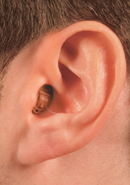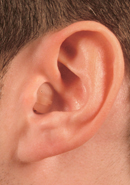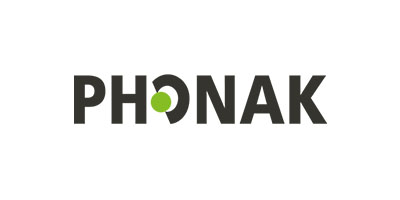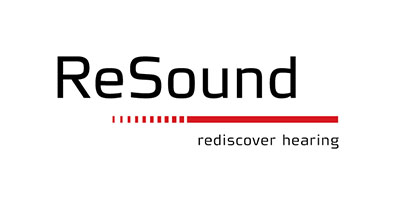Hearing Aid Styles and
Manufacturers
Hearing aids are available in many different sizes and styles, thanks to advancements in digital technology and miniaturization of the internal components. Many of today’s hearing aids are considered sleek, compact, and innovative – offering solutions to a wide range of hearing aid users. When selecting a style of hearing aid, you should consider:
Hearing Aid Styles

Invisible In-The-Canal (IIC)
The smallest custom style, IIC instruments sit invisibly in or past the second bend of the ear canal. IIC are specifically designed for mild to moderate hearing loss.

Completely-in-the-Canal (CIC)
The smallest custom style, CIC instruments fit deeply and entirely within the ear canal. They fit mild to moderate hearing losses and offer high cosmetic appeal as they’re nearly invisible when worn.

In-the-Canal (ITC)
ITC instruments sit in the lower portion of the outer ear bowl, making them comfortable and easy to use. Because they’re slightly larger than CIC models, they have a longer battery life, and can host additional features such as directional microphones for better understanding in noisy environments, and controls such as volume controls. They fit mild and moderate hearing losses.

Full Shell or In-the-Ear (ITE)
Full shell models sit flush within the outer ear bowl. Their size allows the maximum number of additional controls and features such as directional microphones, which require space on the outer portion of the instrument. They use a larger battery size than the smaller styles, and can fit a larger receiver with enough power for even some severe hearing losses. Because of their flexibility, they’re widely recommended for mild to severe hearing loss.

Mini BTE with slim tube and tip
Mini BTEs are designed to hide behind the outer ear, and have ultra-thin tubing to discreetly route sound into the ear. The tubing connects to a soft tip that sits in the ear canal but doesn’t occlude it. The result is a natural, open feeling as airflow and sound enter the ear naturally around the tip, while amplified sound enters through the tip. This is known as “open fitting” and is recommended for mild to moderate high frequency losses.

Receiver in the ear (RITE)
RITE models, also known as RIC (receiver-in-canal) models, are mini BTEs that have the speaker of the instrument incorporated in the ear tip, instead of in the main body of the instrument. RITE instruments fit mild to severe hearing losses. This hearing aid style looks similar to the Mini BTE when worn on the ear.

BTE with earmold
BTEs with earmolds fit mild through profound hearing losses. Their longer shape, following the contour behind the outer ear, generally can house more features, controls, and power than custom models. The earmold color and style, as well as the wearer’s hairstyle, determine exactly how they’ll look on each person.
Hearing Aid Technology
A wide range of technology and a host of features are available in each hearing aid device. The cost of hearing aids generally depends on the technology and the number of features. Today’s digital hearing aids are typically offered in various levels, such as basic or entry-level to advanced or premium-level. Within each level, different technology and features are available.
Basic digital hearing aids generally require the wearer to make some manual adjustments in certain listening environments, such as turning a volume control up or down, or pushing a button to change listening programs. In contrast, a premium or more advanced hearing aid responds automatically to changes in the listener’s environment, making adjustments based on the signals detected by the hearing aid. However, the hearing aid wearer is not required to make any manual changes.
As the level of the technology increases in hearing aids, so does the availability of advanced features. Examples of some of the advanced features found in today’s digital hearing aids include:
Directional Microphones
This applies preference to sounds in front of the wearer and reduces sound from behind the wearer. This technology has been proven in studies to improve speech understanding in background noise.
Noise Reduction
This feature determines if a signal contains unwanted background noise and reduces the level of background sound, if present. Because of this feature, background noise is less annoying, and the hearing aid wearer’s listening comfort is improved in noisy situations.
Feedback Management
Reducing or eliminating bothersome whistling that may occur with hearing aid use, this feature is optimal for many people with hearing loss. Because of this feature, the hearing aid wearer’s comfort is improved.
Wind/Noise Reduction
This feature reduces the noise created from wind blowing across the hearing aid’s microphone(s). This is designed to improve comfort for people who spend a lot of time outdoors.
Data Logging/Learning
This is the ability of the hearing aid to track and learn the hearing aid wearer’s preferences in various listening environments. This information can assist the hearing professional in making future programming adjustments and allows the hearing aid to adapt to the wearer’s preferences.
Telecoil/Auto-telecoil
This feature picks up a signal from a compatible telephone, allowing hearing aid wearers to listen to the telephone without whistling (feedback). Some hearing aids require a push of a button to activate the feature; other manufacturers offer an auto-telecoil, where the hearing aid switches automatically when a telephone signal is detected.
Bluetooth Interface
This technology establishes a wireless connection between hearing aids and Bluetooth-compatible devices. It is designed to improve wearer convenience and use with devices, such as television, telephones, MP3 players, and computers.





